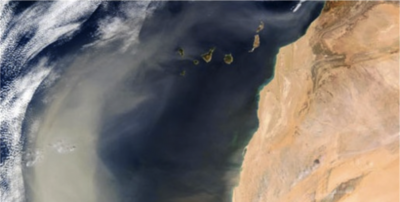Oceans & Climate
The ocean state is both a consequence and cause of the climate and its changes we experience through time. Understanding the ways in which the ocean interacts with the remainder of the climate system—including the atmosphere, cryosphere, and biosphere—is one of the most interesting and challenging of scientific problems. These changes are so important that scientists at MIT and its partners at WHOI and elsewhere bring to bear all of the available tools required to study the system: observations at sea, and from satellites, theory, statistics, and models ranging from the analytical to some of the largest and most sophisticated of any computer model in any field.
 The climate of Earth is to a large degree shaped by the presence of the ocean. Indeed the ocean, and life within it, has constructed the world as we know it, setting the concentration of gases within our atmosphere, acting as a climate thermostat and influencing the transformation of energy, water and carbon within the climate system. To a considerable degree our ability to understand the paleo climate record and anticipate what might happen to earth’s climate in the future, depends on our understanding of the role of the oceans in climate.
The climate of Earth is to a large degree shaped by the presence of the ocean. Indeed the ocean, and life within it, has constructed the world as we know it, setting the concentration of gases within our atmosphere, acting as a climate thermostat and influencing the transformation of energy, water and carbon within the climate system. To a considerable degree our ability to understand the paleo climate record and anticipate what might happen to earth’s climate in the future, depends on our understanding of the role of the oceans in climate.
Already the impacts of climate change on the oceans are very real and pose significant physical, ecological, social and economic challenges for humanity. It is clear that human activities are compromising the health of the oceans and their ability to sustain our lives. For example, ocean surface waters are warming, sea level is projected to rise over the coming century and will threaten coastal communities. Moreover the progressive acidification of the surface ocean (caused by rising atmospheric CO2 levels) will alter ocean chemistry in many ways (e.g. calcium carbonate shell formation and metal speciation) and will thereby alter marine organisms (from phytoplankton up through entire food chain that they feed). These chemical and biological changes may drive feedbacks that alter the role of the ocean in climate (e.g. emissions of climate-active trace gases such as CH4, N2O, and dimethyl sulfide).
The challenge is to understand and model critical aspects of our oceans. These include the transport of heat and salt in the ocean and its role in global energy balance and the hydrological cycle, the interaction of the ocean with the cryosphere, sea-level dynamics, marine ecosystems and biogeochemistry, high latitude processes including convection and the thermohaline circulation.
Key research questions being addressed in PAOC are:
What causes the deep meridional overturning of the oceans that today accounts for roughly one third of the net heat transport from the equator toward Earth’s poles?
What is the role of the ocean in the dynamics of the ice ages and the evolution of climate over time?
What controls the rate at which the ocean sequesters heat and carbon in to its interior, and what are the implications for the future trajectory of earth under global warming?
How might life within the ocean and the biogeochemistry of the ocean change under global warming?

